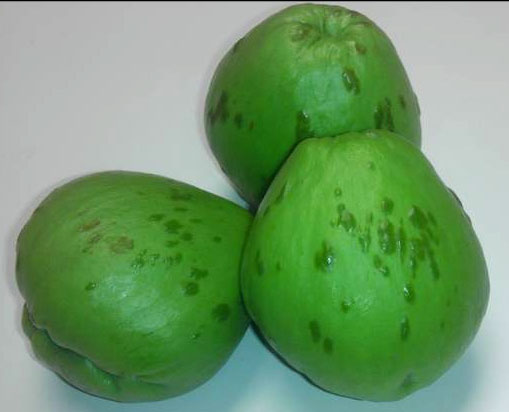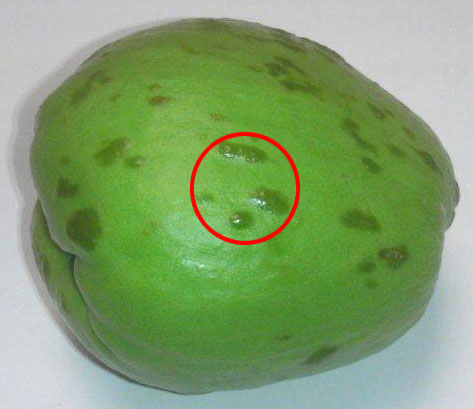I am sure you have noticed the watersoaked, discolored spots on chayote squash. If you take some small, exploratory slices under the discolored spots the underlying flesh will not be affected.

This discoloration is considered a condition defect, meaning it will progress and become worse the longer it is in storage. Unfortunately I do not know the cause of this defect but would welcome any insights. But this site is geared towards the identification and scoring guidelines for defects. You should simply describe the defect, as “numerous watersoaked and discolored spots” and you can further state the area affected, “……affecting from 1 inch to 20% of its surface.”
But how much is allowed, before scoring this as a defect. The USDA guidelines will not be of any help to us. There are inspection instructions and U.S. Grade Standards for summer squash (yellow, zucchini, patty pan, etc.) and for winter squash (butternut, hubbard acorn, etc.). Chayote squash is not covered by either grade standard, meaning there are no tolerances and no scoring guidelines to use. Therefore, we will fall to the old standby, “if it materially affects the appearance or marketability” then the defect shall be scored. There is no doubt the discoloration as shown above materially affects the appearance. All three squash should be scored as a defect.
But what if the chayote squash is showing the watersoaked discoloration, but not to the extent shown above, now what?

For lack of an official USDA scoring guideline, the following scoring guideline may be fair to receivers and shippers. When the watersoaked discolored spots exceed an aggregate area of 1 inch in diameter, score as a defect. If there are no tolerances for defects, then how much is too much? The general rule, when there are no U.S. Grade Standards for a commodity is to allow 10% for defects, including not more than 1% for decay, but PACA would be able to provide definitive tolerances to use.
Let me know if you agree with the scoring guideline of not more than 1 inch in aggregate, or if you have any ideas of the cause of this defect.
To learn more about postharvest diseases of chayote squash, please open:

4 Comments on “Chayote Squash- Watersoaked Discoloration”
I did receive some information regarding this defect. It is a fungal disease, caused by Colletotrichum gloeosporioides. The industry refers to the defect as “bladder” or “blister.” I placed a document on this post, Chayote Postharvest Diseases.
I believe these raised water-soaked lesions, or blisters (‘vejiga’ in Spanish) are caused by the fungus Mycovellosiella cucurbiticola.
Are they edible with these blisters and will boiling the chayote squashes affected kill mycovellosiella cucurbiticola fungus?
Good question Katherine. I’ll defer to an expert as to whether these are blisters are edible or not.